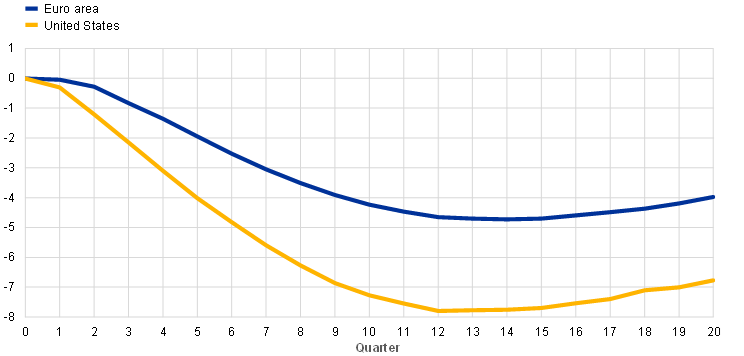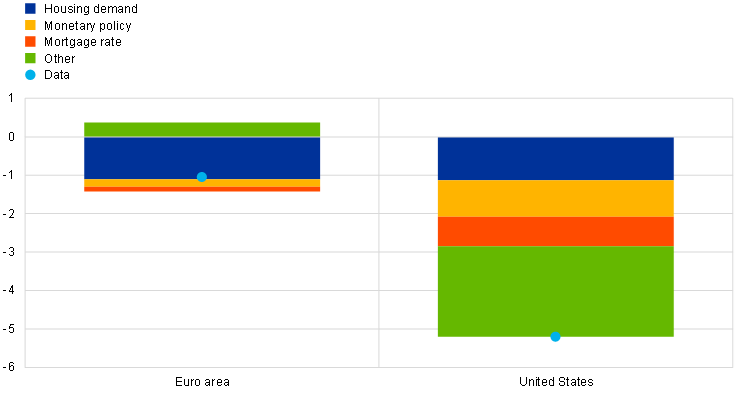
Published as part of the ECB Economic Bulletin, Issue 3/2023.
Housing investment in the euro area and the United States fell significantly in 2022, with the fall being particularly pronounced in the United States. In the euro area, housing investment started to decline in the second quarter of 2022 and recorded a cumulative fall of about 4% by the fourth quarter of 2022 (Chart A, panel a). By contrast, the decline in the United States started as early as the second quarter of 2021. Since then, US housing investment has fallen by around 21% cumulatively, with a particularly sharp decline in the second half of 2022 when the rise in US mortgage rates led to a sharp drop in affordability for homebuyers (Chart A, panel b). These declines have taken place against the backdrop of monetary policy tightening on both sides of the Atlantic, with policy interest rates in the United States being raised earlier and reaching higher levels than euro area policy rates. Against this background, this box analyses the dynamics of housing investment in the euro area and the United States and discusses the impact of the recent monetary policy tightening on future housing investment in the euro area.
Chart A
Housing investment, short-term interest rates and mortgage rates
(quarter-on-quarter percentage changes and percentages per annum)

Sources: Eurostat, ECB, US Bureau of Economic Analysis, Wall Street Journal and ECB staff calculations.
Notes: Short-term interest rates for the euro area refer to the three-month EURIBOR and for the United States to the effective federal funds rate. Euro area mortgage rates refer to the composite indicator of household borrowing costs for house purchase, while mortgage rates for the United States refer to the 30-year fixed mortgage rate. All interest rates are quarterly averages.
While housing investment is one of the most interest rate-sensitive components of economic activity, it is generally much less volatile in the euro area than in the United States. The volatility of quarterly housing investment growth in the euro area is about half that in the United States (Table A). Moreover, housing investment is only about three times more volatile than aggregate output in the euro area, while it is about six times more volatile in the United States. In spite of its smaller contribution to GDP, US housing investment accounts for a larger share of the fluctuations in aggregate output in the United States than in the euro area (see Table A). In both the euro area and the United States, however, housing investment is strongly procyclical and tends to lead the business cycle, underscoring the important role of the housing market in the economy.[1]
Table A
Properties of quarterly housing investment
(quarter-on-quarter percentage changes, percentage shares of GDP and percentages of variance explained)

Sources: Eurostat, US Bureau of Economic Analysis and ECB staff calculations.
Notes: The table shows the standard deviations of quarterly housing investment growth as well as the shares of GDP and percentages of GDP variance explained by housing investment in the period from the first quarter of 1995 to the fourth quarter of 2019. The shares of GDP are expressed in nominal terms, while the shares of variance explained are expressed in real terms. The GDP variance explained by housing investment accounts also for the covariance of housing investment with the sum of the other demand components of GDP.
Mortgage markets in the euro area are less deep than in the United States, although there are some cross-country differences in the euro area.[2] Compared with the euro area, banks in the United States can more easily offload housing loans from their balance sheets, making it easier for these banks to shift the associated risks to third parties, with the government acting as the ultimate guarantor through several government-sponsored enterprises.[3] In addition, borrowers in the United States can withdraw mortgage equity and face only limited fees for early repayments and renegotiations and limited personal liability in the event of insolvency.[4] In terms of the typical maturity of mortgage loans, fixed rate 30-year mortgage contracts predominate in the United States, while shorter fixed maturities of 15-25 years are common in some euro area countries and adjustable rate mortgages prevail in others.[5] Looking at various indicators of mortgage market development, reflecting the differences between mortgage markets in the euro area and the United States, these suggest that the US mortgage market is generally deeper than the euro area market. This is shown by the higher household mortgage indebtedness in the United States (as measured by the mortgage debt-to-GDP ratio), higher securitisation (measured by the mortgage-backed securities-to-GDP ratio) and higher leverage (measured by the mortgage debt-to-housing wealth ratio) across the household net wealth distribution (Chart B).
Chart B
Indicators of mortgage market development
(percentage of nominal GDP and percentage of housing wealth)

The lesser depth of euro area mortgage markets tempers the transmission of monetary policy shocks to housing investment. Empirical evidence typically finds that monetary policy shocks, i.e. unexpected changes in monetary policy interest rates, have stronger effects on housing investment in countries with deeper mortgage markets, such as the United States.[6] Indeed, the characteristics of the mortgage market in the United States reinforce the interaction between interest rate changes and credit access: easier terms for mortgage refinancing and equity release strengthen the incentives for households to buy houses when interest rates fall, while the resultant greater indebtedness means that households are more sensitive to interest rate changes when interest rates rise.[7] However, this higher sensitivity is also influenced by the shares of fixed rate and adjustable rate mortgages, with the greater prevalence of fixed rate mortgages in the United States suggesting a more muted transmission of monetary policy.[8] Countering this, however, is the fact that the higher level of mortgage securitisation in the United States causes the mortgage market to be more closely linked to the broader capital markets, as the pricing of mortgage-backed securities has a direct influence on mortgage rates. This leads to a more direct transmission of changes in monetary policy interest rates to mortgage rates and thus housing investment.[9]
Housing investment in the euro area has been more sheltered from recent monetary policy shocks than in the United States. A Bayesian vector autoregression (BVAR) model is estimated for both the euro area and the United States for the period from the first quarter of 1995 to the fourth quarter of 2022.[10] The model includes real private consumption, the consumption deflator, housing investment, real house prices and short-term interest rates, as well as mortgage rates. It identifies three structural drivers for housing investment, namely monetary policy, the mortgage rate and housing demand shocks.[11] According to the results of the estimation, a temporary monetary policy shock that increases the short-term interest rate by 1 percentage point on impact leads, all else being equal, to a decline in housing investment in the euro area of around 5% after about three years (Chart C, panel a). However, in the United States, the same shock has a greater impact on housing investment, leading to a drop of around 8% after about three years.[12] Consistent with these much more pronounced effects in the United States, especially in the first year after the shock, and partly owing to the larger size of the monetary policy shocks, the recent monetary policy tightening in the United States is estimated to have had a larger impact on housing investment growth in 2022 than seen in the euro area (Chart C, panel b). In addition, the estimation results show that mortgage rate shocks also had a greater impact on housing investment in the United States compared with the euro area, while housing demand shocks weighed on housing investment to broadly the same extent in the two jurisdictions.[13]
Chart C
Housing investment and its drivers
a) Impact on housing investment of a 1 percentage point increase in the short-term interest rate owing to a monetary policy shock

b) Changes in average quarterly housing investment growth between 2021 and 2022
(percentage points and percentage point contributions)

Sources: Eurostat, ECB, US Bureau of Economic Analysis, Wall Street Journal, Wu and Xia (2017) op. cit. and ECB staff calculations.
Notes: Panel a) shows the estimated effect on the housing investment level of a 1 percentage point increase in the short-term interest rate owing to a monetary policy shock. Panel b) shows the change in average quarterly housing investment growth between 2021 and 2022 and estimated drivers. The results are based on a separately estimated BVAR model for the euro area and the United States, with the shocks being identified with zero and sign restrictions. The effects shown in panel a) are significantly different from zero at the 90% confidence level.
The outlook for housing investment in the euro area is weak, despite the recent resilience. While housing investment is generally less volatile and was less affected by the recent tightening of monetary policy than housing investment in the United States, the negative effects of the increase in monetary policy interest rates in the euro area are likely to intensify over time, given the estimated lagged effects of monetary policy. Indeed, the March 2023 ECB staff macroeconomic projections for the euro area forecast a protracted and substantial decline in euro area housing investment this year and next year.






